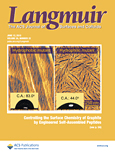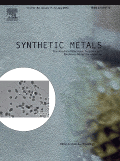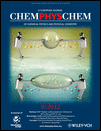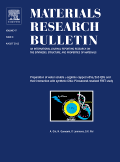
LANGMUIR
Scope & Guideline
Exploring Innovative Discoveries in Surface Science
Introduction
Aims and Scopes
- Surface Chemistry and Interfacial Phenomena:
The journal extensively covers the chemistry of surfaces and interfaces, including adsorption phenomena, surface functionalization, and the interactions of molecules at surfaces, which are crucial for applications in catalysis, sensors, and nanotechnology. - Nanomaterials and Nanocomposites:
Research involving the synthesis, characterization, and application of nanomaterials, including their role in enhancing material properties and their use in environmental remediation, energy storage, and conversion technologies. - Colloidal Science and Emulsions:
The journal publishes studies on colloidal systems, including the stabilization of emulsions, foams, and dispersions, along with the fundamental understanding of colloidal interactions and dynamics. - Biomaterials and Biointerfaces:
Research on the interactions between biomaterials and biological systems, including studies on drug delivery systems, antimicrobial surfaces, and the behavior of biological molecules at interfaces. - Photocatalysis and Environmental Applications:
The journal includes research on photocatalytic processes for environmental remediation, focusing on the mechanisms and efficiencies of materials designed to degrade pollutants or convert solar energy into chemical energy. - Electrochemistry and Energy Storage:
Studies on electrochemical systems, including batteries, supercapacitors, and fuel cells, with a focus on material interfaces and charge transfer dynamics.
Trending and Emerging
- Advanced Functional Materials:
There is an increasing emphasis on the development of advanced functional materials, particularly those that exhibit unique properties at the nanoscale, for applications in electronics, energy storage, and environmental remediation. - Smart and Responsive Materials:
Research on smart materials that respond to external stimuli (e.g., pH, temperature, light) is gaining traction, particularly in the context of drug delivery systems and adaptive surfaces. - Sustainable and Green Chemistry:
An emerging trend focuses on the sustainable synthesis and application of materials, including biodegradable polymers and environmentally friendly processes, aligning with global sustainability goals. - Machine Learning and Computational Modeling:
The integration of machine learning techniques and computational modeling to predict material behavior and optimize processes is increasingly prevalent, showcasing a trend towards data-driven research. - Interfacial Behavior in Complex Fluids:
Studies exploring the interfacial dynamics and behaviors in complex fluids, such as emulsions and foams, are becoming more popular, reflecting the need for innovative solutions in food, pharmaceuticals, and cosmetics.
Declining or Waning
- Classical Surface Science Techniques:
Research based solely on classical surface science techniques, such as simple adsorption isotherm studies, has seen a decline as more advanced methodologies, including molecular dynamics simulations and advanced spectroscopic techniques, gain prominence. - Traditional Materials Characterization:
Papers focusing exclusively on conventional methods of materials characterization without integration of novel approaches or applications are becoming less frequent, as interdisciplinary approaches are favored. - Single-Phase System Studies:
Research focused solely on single-phase systems, without considering the complexities of multi-phase interactions, is less common as the field moves towards understanding more complex, real-world scenarios. - Localized Studies on Specific Molecules:
There is a decreasing trend in publications that focus narrowly on the behavior of specific molecules at interfaces without a broader context or implications for applications, as researchers seek to address larger, more integrative questions.
Similar Journals

SYNTHETIC METALS
Exploring New Frontiers in Metallic Materials.SYNTHETIC METALS is a leading academic journal published by Elsevier Science SA, focusing on the interdisciplinary field of materials science with an emphasis on the development and application of synthetic metallic materials. Established in 1979, this esteemed journal offers a platform for innovative research that promotes advancements in condensed matter physics, electronic materials, materials chemistry, and mechanical engineering. With an impressive Q1 ranking in Metals and Alloys and Q2 rankings across various other categories, SYNTHETIC METALS serves as a vital resource for researchers, professionals, and students seeking to explore complex material systems and their applications in industry. Although it does not currently offer open access, the journal's impact is highlighted by its robust Scopus rankings, ensuring high visibility and dissemination of meaningful research outcomes. As it progresses through its convergence period to 2024, SYNTHETIC METALS remains dedicated to advancing knowledge and fostering scientific inquiry in the field of materials science.

CHEMPHYSCHEM
Delving Deep into the Dynamics of Atomic and Molecular PhenomenaCHEMPHYSCHEM, published by WILEY-V C H VERLAG GMBH in Germany, stands as a pivotal resource for researchers and professionals in the fields of Atomic and Molecular Physics, as well as Physical and Theoretical Chemistry. With a commendable impact across its converged years from 2000 to 2024, the journal is categorized in the second quartile (Q2) for both aforementioned fields according to the 2023 metrics, underscoring its significance in advancing scientific dialogue and research. CHEMPHYSCHEM is committed to disseminating high-quality, peer-reviewed research articles that delve into the intricate interplay between chemistry and physics, making it an essential read for students and experts alike. The journal does not currently offer open access options, allowing for focused scholarly discussions that cater to the academic community's needs. As reflected in its Scopus rankings, CHEMPHYSCHEM maintains respectable standings, ranking #84/224 and #90/189 in its respective categories, demonstrating its commitment to high-impact research and innovation.

CHEMICAL PHYSICS LETTERS
Pioneering Insights in Physical and Theoretical ChemistryCHEMICAL PHYSICS LETTERS, published by Elsevier, is a prestigious journal that has been at the forefront of advancing knowledge in the fields of physical and theoretical chemistry and physics since its inception in 1967. With an impressive impact factor reflective of its high-quality research output, this journal holds Q2 quartile rankings in both the Physical and Theoretical Chemistry and Physics and Astronomy categories for 2023. It is recognized as a key platform for disseminating groundbreaking findings, with Scopus rankings placing it within the top 76th and 66th percentiles in its respective categories. Researchers and professionals benefit from its insightful contributions and rigorous peer-review process, making it an essential resource for those engaged in cutting-edge chemical physics studies. Although the journal is not open access, it remains accessible through various institutional subscriptions, ensuring that a wide audience can explore its wealth of knowledge. Located in Amsterdam, Netherlands, the journal continues to drive innovation and collaboration across diverse scientific disciplines.

Journal of Physical Chemistry Letters
Bridging Disciplines, Transforming KnowledgeThe Journal of Physical Chemistry Letters, published by the American Chemical Society, is a premier journal in the fields of Physical and Theoretical Chemistry, Materials Science, and Nanoscience and Nanotechnology. Since its inception in 2010, this journal has established itself as a significant platform for rapid publications of cutting-edge research that bridges various branches of chemistry, providing a critical avenue for advancing knowledge in these dynamic fields. With an impressive impact factor and a consistent ranking in the top quartile (Q1) of its categories, the journal ranks 25th out of 189 in Physical and Theoretical Chemistry and 79th out of 463 in General Materials Science according to Scopus metrics. Although it currently does not operate under an open access model, it remains an essential resource for academics seeking to disseminate their findings to a global audience. Researchers, professionals, and students alike will find invaluable insights and contributions that push the boundaries of scientific inquiry within these disciplines.

SURFACE AND INTERFACE ANALYSIS
Bridging Disciplines through Surface ScienceSURFACE AND INTERFACE ANALYSIS, published by WILEY in the United Kingdom, is a renowned journal specializing in the examination of nanoscale phenomena and the properties of surfaces and interfaces across various materials. With a focus on advancing the fields of Chemistry, Condensed Matter Physics, and Materials Science, this journal has established itself as a critical resource since its inception in 1979, bridging over four decades of scientific discourse. Notably, it holds a commendable position in the Scopus rankings, emerging in the 2023 Q3 quartile across multiple categories, including Chemistry (miscellaneous) and Surfaces, Coatings, and Films. Although it does not currently offer Open Access, SURFACE AND INTERFACE ANALYSIS remains pivotal in disseminating high-quality research, providing an essential platform for academic scholars, industry professionals, and students aiming to deepen their understanding of surface phenomena and material characteristics. Its comprehensive coverage of innovative methodologies, experimental results, and theoretical insights reaffirm its significance in the scientific community.

Advanced Materials Interfaces
Advancing Knowledge at the Interfaces of InnovationAdvanced Materials Interfaces is a premier journal dedicated to the exploration and advancement of materials science, with particular emphasis on the interfacial phenomena that govern the behavior of materials in various engineering applications. Published by WILEY in the United Kingdom, this Open Access journal, established in 2014, has quickly ascended to a Q1 category ranking in both Mechanical Engineering and Mechanics of Materials as of 2023, reflecting its significant influence and excellence in the field. With impressive Scopus Ranks, such as #81 out of 672 in Mechanical Engineering and #58 out of 398 in Mechanics of Materials, it serves as a vital resource for researchers and practitioners aiming to push the boundaries of materials innovation. The journal provides unrestricted access to its cutting-edge research, promoting collaboration and dissemination of knowledge among the global scientific community, solidifying its role as a vital contributor to the ever-evolving landscape of materials engineering.

MATERIALS RESEARCH BULLETIN
Transforming ideas into impactful materials solutions.MATERIALS RESEARCH BULLETIN is a prestigious journal published by Pergamon-Elsevier Science Ltd, dedicated to advancing the field of materials science and engineering. Since its inception in 1966, the journal has served as a platform for high-impact research, particularly in areas such as condensed matter physics, mechanical engineering, and materials mechanics. With an impressive Q1 ranking in multiple categories, including Condensed Matter Physics and Materials Science, MATERIALS RESEARCH BULLETIN stands out as a leading resource in its domain, aiming to disseminate innovative research findings and methodologies that address fundamental and applied aspects of materials. The journal’s rigorous peer-review process ensures the publication of high-quality articles, making it an essential resource for researchers, professionals, and students alike. With its ongoing commitment to fostering scientific discourse and collaboration, MATERIALS RESEARCH BULLETIN remains at the forefront of materials research, contributing significantly to the global scientific community.

JOURNAL OF CLUSTER SCIENCE
Innovating Insights Across Chemistry and PhysicsJOURNAL OF CLUSTER SCIENCE, published by SPRINGER/PLENUM PUBLISHERS, is a prominent and influential journal in the fields of Biochemistry, Chemistry, Condensed Matter Physics, and Materials Science. With an ISSN of 1040-7278 and E-ISSN of 1572-8862, this journal has been contributing to scientific discourse since its inception in 1990 and continues to publish cutting-edge research through 2024. It holds a respectable position in the academic landscape with its category quartiles indicating a Q3 ranking in Biochemistry and Q2 rankings in Chemistry, Condensed Matter Physics, and Materials Science as of 2023. The journal's noteworthy Scopus rankings further underscore its relevance, particularly a rank of #82 in Condensed Matter Physics, showcasing its impact and the quality of research disseminated. Although it does not currently offer open access options, it remains a key resource for researchers, professionals, and students who are invested in understanding the complexities of cluster science and its interdisciplinary applications.

RARE METALS
Connecting Innovators in Materials ScienceRARE METALS is a prestigious journal at the forefront of materials science, dedicated to advancing the understanding of metallic materials and their applications. Published by the Nonferrous Metals Society of China, this journal has established itself as a leading platform for cutting-edge research in areas including condensed matter physics, materials chemistry, metals and alloys, and physical and theoretical chemistry. With an impressive impact factor and consistently ranked within the Q1 quartile across multiple categories, RARE METALS ranks highly on Scopus, illustrating its significant contribution to the field—such as a remarkable rank of 11/176 in Materials Science for Metals and Alloys and 23/434 in Condensed Matter Physics. Although it operates under a subscription model, its rigorous peer-review process ensures that only the most impactful research is published, making it an essential resource for researchers, professionals, and students engaged in material innovation. Join the global network of materials science by contributing to or exploring the wealth of knowledge RARE METALS offers, fostering advancements in areas vital for technological progress and industrial applications.

CURRENT OPINION IN COLLOID & INTERFACE SCIENCE
Elevating Research Standards in Colloid ScienceCURRENT OPINION IN COLLOID & INTERFACE SCIENCE, published by Elsevier Science London, serves as a premier platform for researchers and professionals in the field of colloid, interface science, and related disciplines. With an impressive Q1 ranking in multiple categories including Colloid and Surface Chemistry, Physical and Theoretical Chemistry, Polymers and Plastics, as well as Surfaces and Interfaces, this journal showcases cutting-edge developments and expert opinions that drive innovation in these areas. As a leader in its field, it maintains robust academic standards, reflected in its high percentile rankings across various Scopus categories, such as 3rd in Surfaces and Interfaces and 10th in Physical and Theoretical Chemistry. While the journal is not Open Access, it provides valuable insights to a wide audience, making it an essential resource for advancing knowledge and fostering collaborations among researchers, academics, and industry professionals alike. With a continual publication timeline extending from 1996 to 2024, it captures the evolving landscape of colloid and interface science, ensuring that readers are equipped with the latest findings and perspectives.